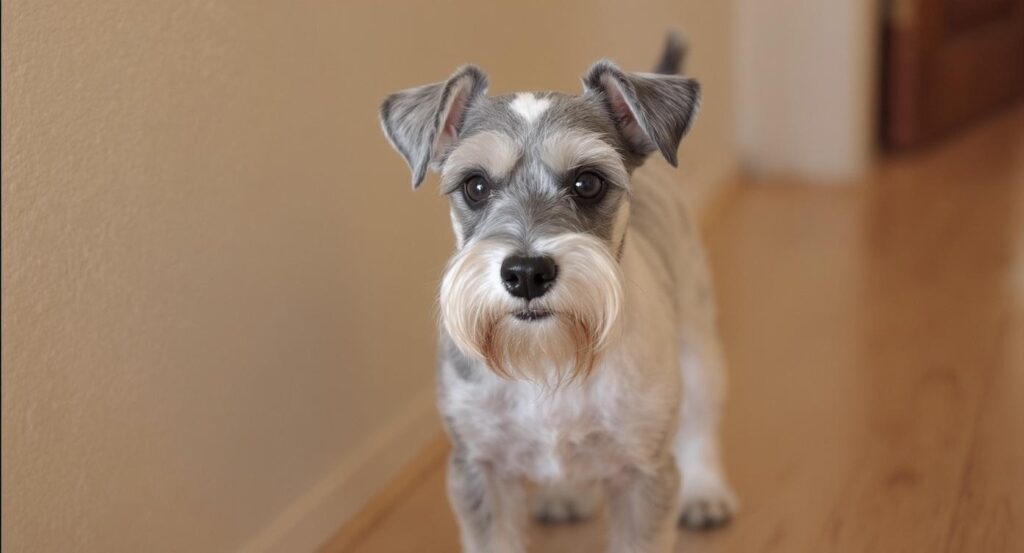Training a Great Dane might seem like a huge task, but honestly, it doesn’t have to be overwhelming. These dogs are gentle giants, and with a steady, kind approach, you can help them grow into calm, well-mannered companions.
The real trick is sticking to simple, consistent steps that build trust and good habits right from the start.
Early training, positive reinforcement, and the right environment go a long way in shaping your dog’s behavior. If you focus on gentle guidance instead of harsh corrections, you’ll make training smoother for both you and your Great Dane.
Start training early, ideally between 8 and 16 weeks for best socialization
Begin training your Great Dane as soon as you bring them home, usually around 8 weeks old. Puppies at this age are more open to learning and adjusting to new routines.
Starting early lets you set clear expectations right away. Between 8 and 16 weeks, your puppy hits a key socialization stage.
They’re more willing to explore new people, places, and sounds. Give them safe, positive experiences now to help them grow into confident adults.
Keep sessions short and simple. Focus on basics—sit, stay, gentle leash walking.
Offer rewards like praise or small treats to keep them interested. Introduce your puppy to new environments gradually.
Let them meet friendly dogs, hear everyday noises, and walk on different surfaces. These little steps help prevent fear or nervousness as they grow.
Use positive reinforcement like treats and praise to encourage good behavior
When your Great Dane does something right, reward them immediately. A small treat or a happy “good dog!” helps them connect the dots.
Timing really matters here, so keep your rewards quick and consistent. You don’t always need food—praise, petting, or a quick play session can work too.
Honestly, a mix of treats and positive attention keeps most dogs motivated. Keep your rewards clear and simple.
Say “good sit” in a cheerful voice while giving a treat. Great Danes can be sensitive, so positive reinforcement builds trust.
Rewarding good behavior instead of punishing mistakes helps your dog feel safe and eager to learn.
Keep training sessions short to hold your Great Dane’s attention
Your Great Dane’s attention span is short, especially as a puppy. Long training sessions just make them tune out or get frustrated.
Stick to 5 to 15 minute sessions. That’s usually enough to work on one skill without overwhelming your dog.
You can always add short sessions throughout the day instead of cramming everything into one block. Focus on one command or behavior at a time.
Trying to teach too many things at once only confuses your dog. End each session with a little win and a reward.
That way, your Great Dane looks forward to the next lesson. Short, positive lessons add up over time.
Be consistent with commands and rules to avoid confusion
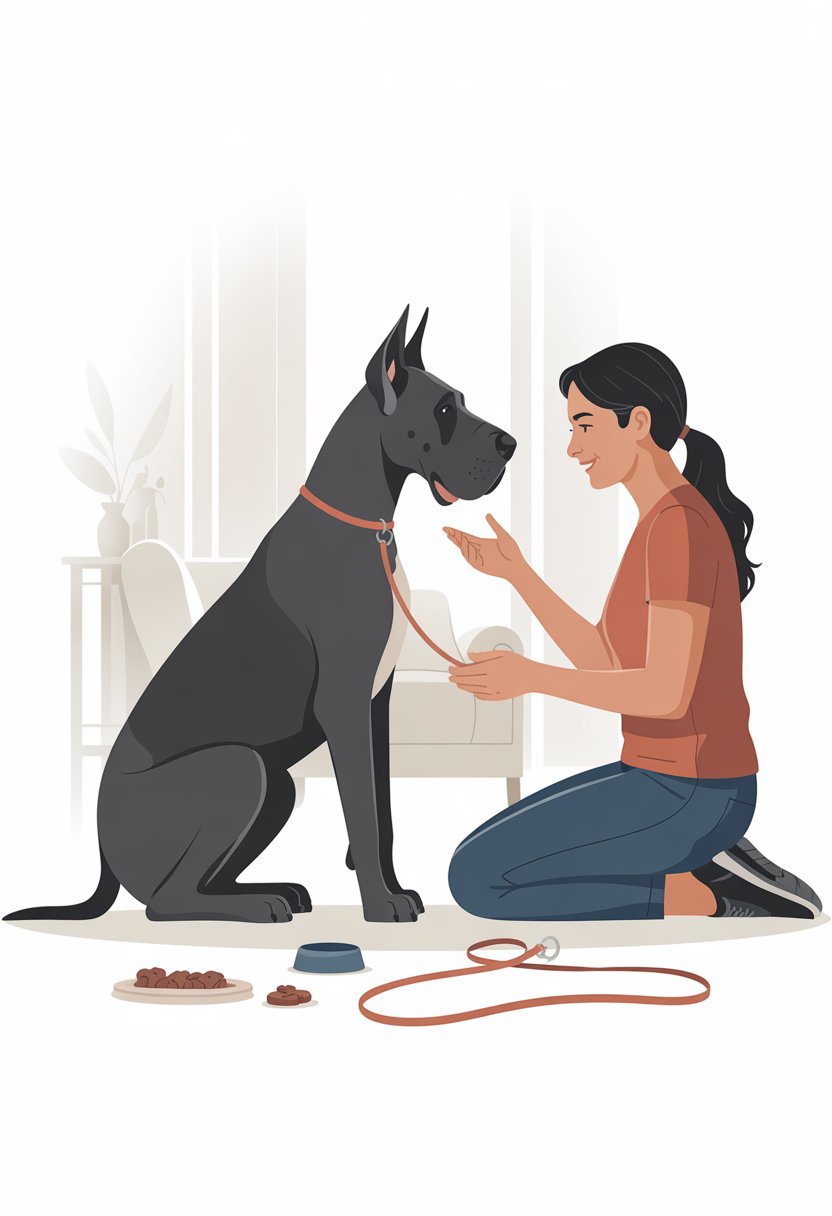
Your Great Dane learns best when you keep things steady and predictable. Use the same word or gesture every time so your dog can connect the command with the action faster.
If you change words or rules, you’ll slow their progress and send mixed signals. Make sure everyone in your home sticks to the same approach.
If one person says “down” and another says “off,” your dog will just get confused. Clear, uniform commands help your Dane feel secure and understand what you want.
Stick to the same rules each day. If you let your dog on the couch one day and scold them the next, you’re just asking for trouble.
Consistency builds good habits. Training sessions should follow the same pattern, too.
Use the same cues, tone, and rewards each time. With repetition, your dog will respond more quickly and confidently.
Socialize your Great Dane with people and other pets regularly
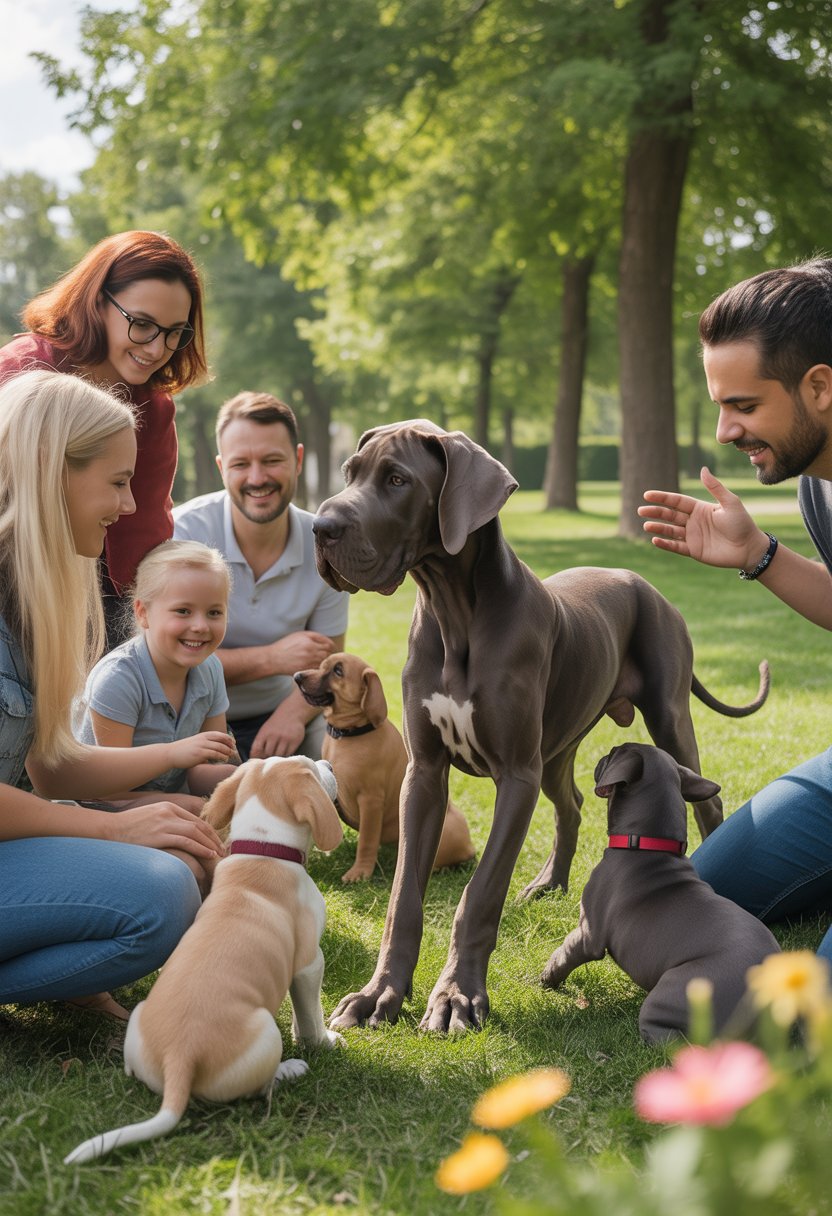
Start socialization early so your Great Dane grows up comfortable around people and other animals. Puppies between 4 and 12 weeks are especially open to new experiences, but keep practicing as they get older.
Bring your dog to calm, safe places where they can meet new people. Let them explore at their own pace—no need to rush.
Introduce other pets slowly and in a controlled setting. Short, positive meetings help prevent fear or rough play, especially since Great Danes get big fast.
Use treats, praise, and a calm vibe to reward good behavior during these meetups. That way, your dog connects social time with positive experiences.
Keep social sessions short and regular. A little practice every day beats one big, overwhelming outing.
As your Dane grows, keep exposing them to different environments. Meeting new people, hearing unfamiliar sounds, and being around other dogs will help them stay relaxed and confident.
Provide plenty of exercise to burn off their energy

Your Great Dane might look chill, but they need regular exercise to stay healthy and easy to live with. Without enough activity, they get restless and harder to handle.
A daily walk is the simplest way to get them moving. Don’t just settle for a quick trip—longer walks help them stretch out and burn energy.
Playtime in a safe yard or open space is great, too. Games like fetch or gentle running give them both mental and physical stimulation.
Try low-impact dog sports or structured activities when you can. These keep their big bodies moving without stressing their joints.
Adding puzzle toys or training exercises gives them a mental workout, which can tire them out almost as much as running around. This balance helps keep your Great Dane calm at home.
Practice basic obedience commands daily for good manners
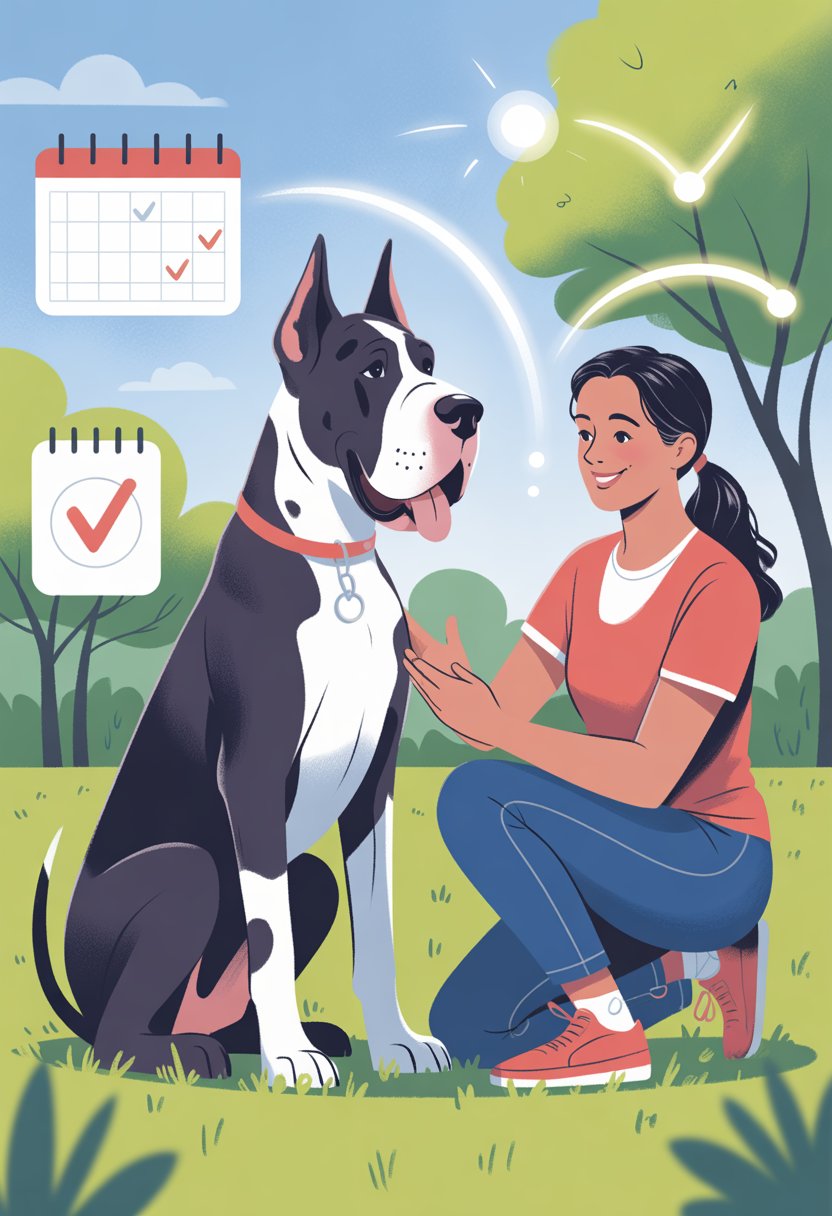
You set the tone for your Great Dane’s behavior by practicing simple commands every day. Short, regular sessions help your dog remember what you expect and make training feel natural.
Start with basics like sit, stay, come, and down. These commands give your dog structure and clear direction.
Use treats, praise, or a favorite toy as rewards. Positive feedback encourages your dog to repeat the behavior.
Avoid punishment—it just adds stress and confusion. Practice in different places, like your backyard or a quiet park.
This helps your dog follow commands even with new distractions. Keep sessions short, around 5 to 10 minutes.
Your Great Dane will stay focused, and you’ll both avoid frustration. Consistency matters way more than long sessions.
Make training part of your daily routine. Ask for a sit before meals or a stay before opening the door.
With steady practice, your dog will respond more reliably. Plus, daily practice builds your bond and helps your Dane look to you for guidance.
Be patient and avoid punishment; focus on gentle guidance
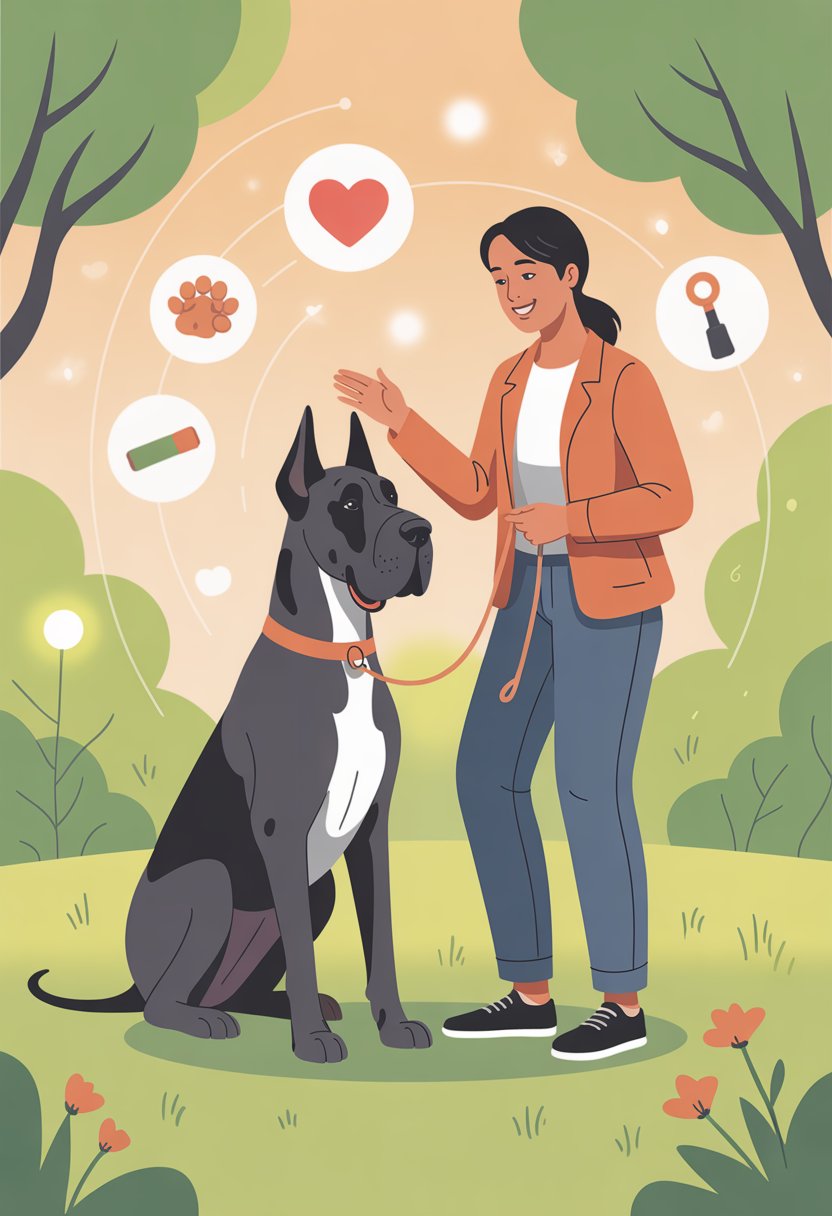
Training a Great Dane takes time—there’s just no way around it. Patience really pays off.
Don’t expect your dog to learn everything overnight. Give them space to practice and grow at their own pace.
Skip the punishment when your dog messes up. Harsh corrections just add stress and slow down learning.
Instead, calmly guide your dog back to the right behavior. Use positive reinforcement like treats, praise, or play when your Great Dane gets it right.
Gentle guidance means showing your dog what you want, not just telling them what they did wrong. Redirect their attention and keep commands simple.
Stay consistent with your cues and reactions. Over time, your Great Dane will learn what to expect and feel more secure.
Use mental stimulation games to keep their mind sharp

Your Great Dane needs more than physical exercise to stay balanced. Mental games help them use their brain and keep boredom—and unwanted behavior—at bay.
A few minutes of brain work can tire them out as much as a walk. Start with puzzle toys that make your dog work for treats.
These toys challenge their problem-solving skills and keep them focused. Switch up the puzzles often so they don’t get bored.
Try teaching new commands or simple tricks. Learning keeps their mind active and strengthens your bond.
Even practicing old commands in new spots can give them a mental workout. Hide-and-seek games are another easy win.
Hide treats around the house or hide yourself and let your dog find you. It taps into their hunting instincts in a fun way.
Short training sessions mixed with games work best. Keep things positive and light so your Great Dane actually enjoys the challenge.
Over time, these activities help them stay calmer, more focused, and way easier to train.
Understanding Your Great Dane’s Temperament
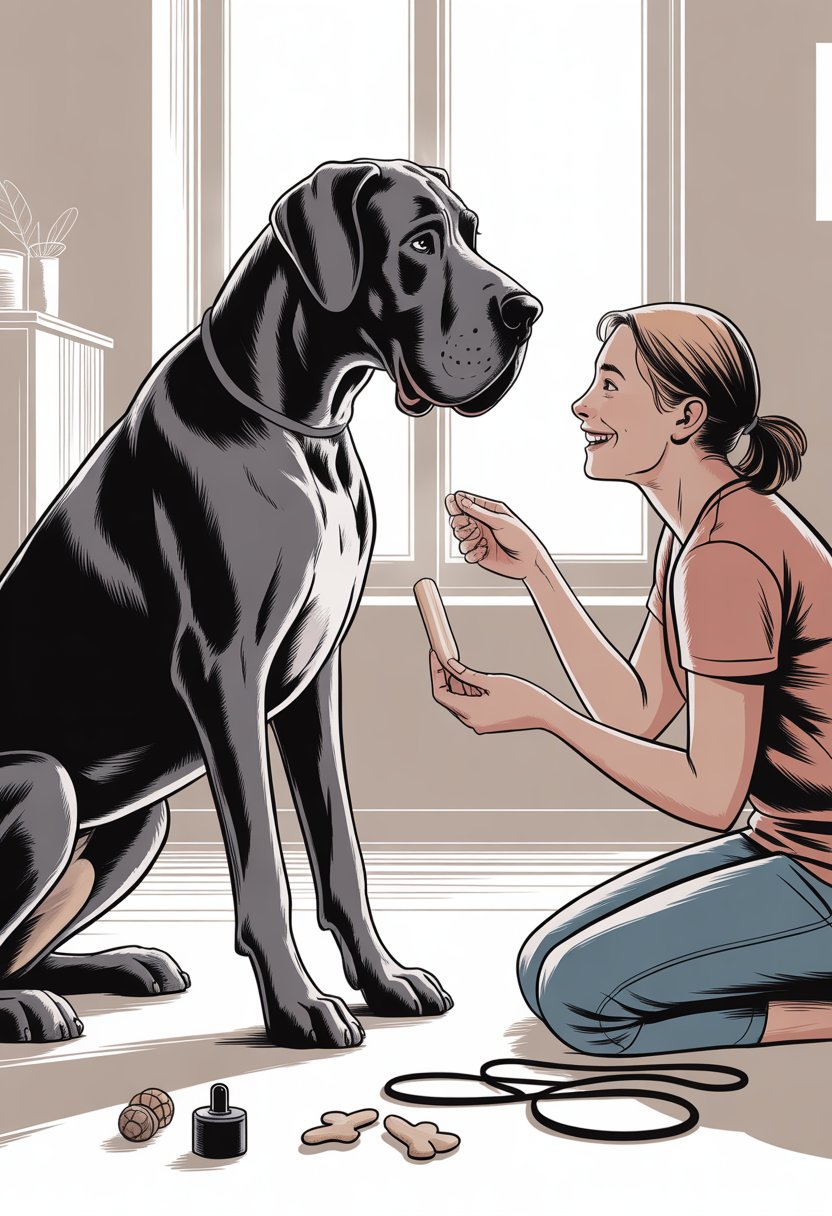
Great Danes have a calm, friendly vibe, but their size and strength set them apart from smaller breeds. Training them isn’t quite the same—what works for a Yorkie might not fly for a dog the size of a small horse.
Their large build really shapes which methods make sense. You’ve got to work with their personality and their sheer size, or things get tricky fast.
Common Personality Traits
Most folks call Great Danes gentle giants for a reason. They’re affectionate and love being around people, sometimes forgetting just how big they are.
Honestly, they might even try to crawl into your lap. It’s sweet, but you’ll feel it!
They don’t like being left alone for too long. If you’re gone all day, they can get anxious or bored.
Danes are usually patient and do well with kids, but accidents can happen if playtime gets rowdy. It’s smart to keep an eye on them when kids are around, just in case.
They thrive on positive reinforcement. Praise and treats go a long way, while harsh discipline tends to just stress them out.
They read your mood and body language fast. If you stay calm and clear, they’re way more likely to get what you want.
How Size Impacts Training
Their size is no joke—a grown Dane can weigh as much as you do. Teaching manners early isn’t just helpful; it’s necessary.
If you let them jump up or pull on the leash, you’re asking for trouble. Those habits get dangerous real quick.
Leash training matters a ton. Even a short stroll can turn into a tug-of-war if you’re not careful.
A sturdy harness helps, and practicing loose-leash walking keeps things manageable. You don’t want to get dragged down the block.
They don’t need hours of intense exercise. Usually, 30–60 minutes of walking and gentle play does the trick.
Push them too hard, especially when they’re young, and you risk hurting their joints. That’s not worth it.
Simple boundaries—like waiting at the door or taking stairs slowly—make life easier for both of you. Teaching these early helps you handle their size and keeps everyone safe.
Setting Up a Positive Training Environment
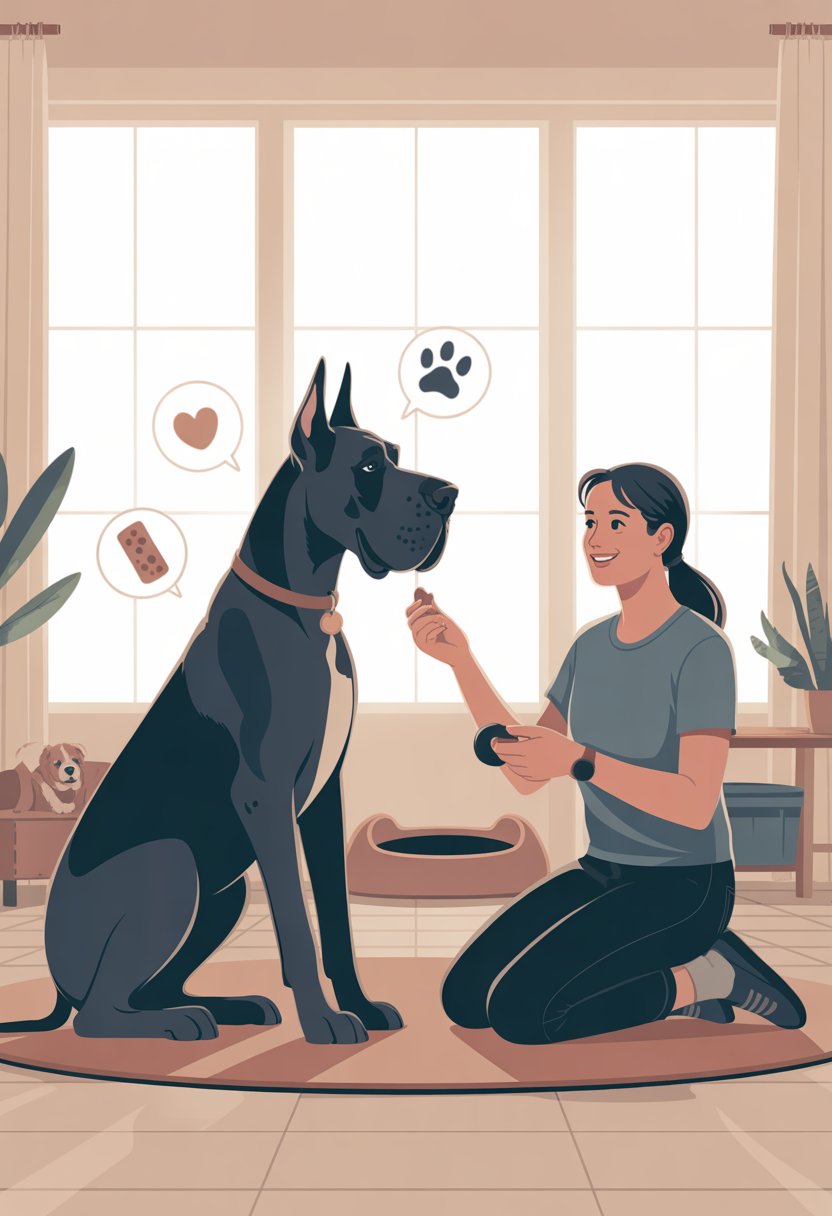
Great Danes learn best in a calm, steady environment. The spot you pick and how you cut down on distractions really matter.
Choosing the Right Space
Pick a spot with enough room for your Dane to move without bumping into stuff. Tight spaces just make them frustrated.
Start indoors if you can. Living rooms or kitchens with open floor space work well.
Use the same area regularly so your dog knows, “Hey, it’s training time.” That routine helps.
Lighting counts. Good light lets your dog see your signals, and solid flooring keeps them from slipping or getting nervous.
Keep things simple. Remove anything fragile or distracting—cords, knickknacks, whatever. The fewer distractions, the better they’ll focus.
Minimizing Distractions
Your Great Dane will focus better if you cut down on noise and movement around them. Turn off the TV and lower the music volume.
Ask family members not to interrupt while you train. If your house is usually busy, try short sessions when things quiet down.
Early mornings or evenings often work best. Sometimes, outside spaces help too, but start in a fenced yard with fewer distractions.
Move to busier spots like parks only after your dog gets used to new sounds and sights. That way, they can adjust without feeling overwhelmed.
Keep training tools—like treats, toys, or a clicker—within reach. You don’t want to lose their focus by searching for supplies in the middle of a session.



